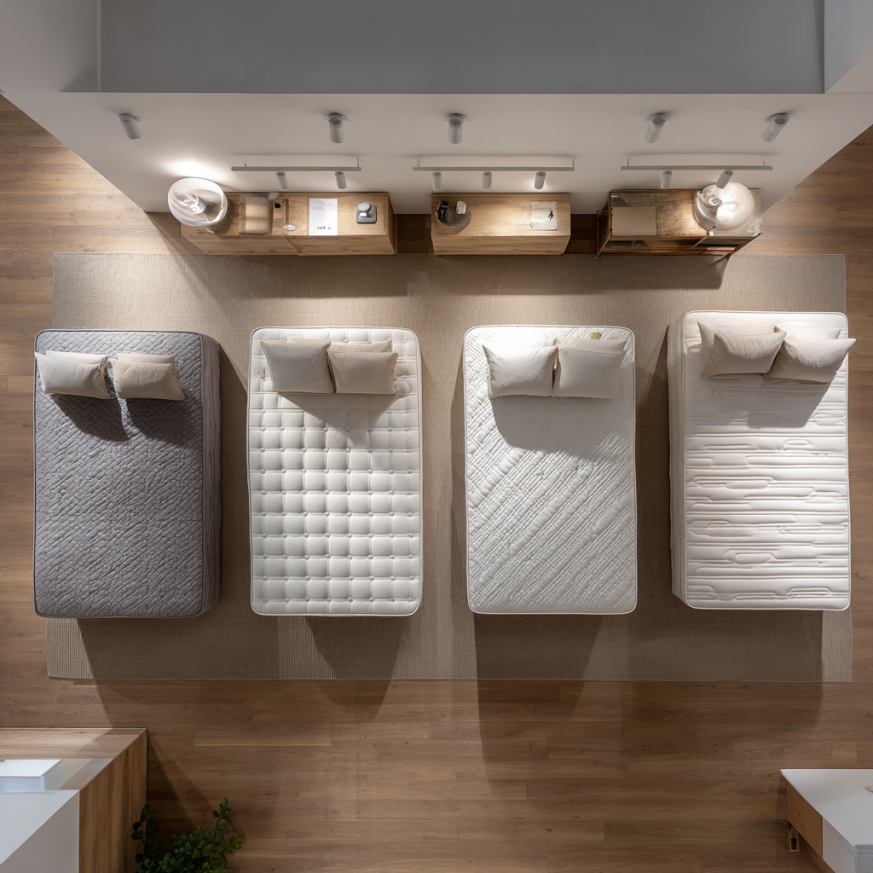Choosing the Right Bedding and Mattress
Choosing the right bedding and mattress is key to achieving the restful sleep you deserve. In this guide, we explore everything from mattress types to bed linen materials—helping you build your perfect sleep sanctuary with comfort and practicality in mind. For a relaxing bedtime atmosphere, read our tips on using essential oils for relaxation.
When it comes to choosing the right bedding and mattress, it’s essential to consider your personal preferences and sleeping habits. A well-thought-out selection can significantly enhance your sleep quality.
Choosing the Right Bedding and Mattress: Key Takeaways
- Mattress Selection Matters: Choose memory foam for pressure relief, latex for breathability, or innerspring for traditional support—tailored to your sleep style.
- Choosing the Right Bedding and Mattress for Your Needs: Think about your sleep position and any health concerns when selecting the right bedding and mattress for you.
- Bedding Materials Influence Sleep: Cotton, silk, and linen each offer distinct textures and benefits. Match material to your comfort and climate needs.
- Flat vs. Fitted Sheets: Fitted sheets provide a secure fit, while flat sheets enhance hygiene and layering flexibility.
- Thread Count Isn’t Everything: Prioritize fiber quality and weave—long-staple cotton outperforms ultra-high thread counts.
- Linen Choices Reflect You: Style, comfort, and care preferences should guide your bed linen selections.
- Go Organic for Health & Sustainability: Natural bedding is chemical-free, durable, and better for the environment.
- Common Bedding FAQs Answered: Practical insights on back pain relief, bedding combos, material comparisons, and more.
Memory Foam vs. Latex vs. Innerspring: Which Mattress is Right for You?
Understanding the differences can help in choosing the right bedding and mattress for optimal comfort and support.
Choosing the right mattress can feel overwhelming with so many styles and features on the market. Learn more about each mattress style in our guide to mattress types.

From Cotton to Silk: A Guide to Bedding Material Choices
The feel of your sheets plays a big role in your nightly comfort. While aesthetics matter, it’s the texture, breathability, and maintenance needs that really define your sleep experience. Here’s what to know about popular bedding fabrics:
- Cotton: A versatile favorite, cotton is soft, breathable, and easy to wash. Egyptian and Pima cotton offer superior quality with long, strong fibers that grow softer over time. For a cooler, crisper sleep, percale weaves are ideal, while sateen gives a silkier finish.
- Silk: Luxurious and naturally temperature-regulating, silk bedding feels indulgent and is especially beneficial for sensitive skin. Its smooth surface minimizes friction on hair and skin—great for preventing breakouts and bedhead.
- Linen: Loved for its earthy texture and breezy feel, linen is ultra-breathable and wicks moisture effectively. It’s the perfect summer sheet and continues to soften with each wash, giving it a lived-in charm. Plus, it’s biodegradable and eco-friendly.
Consider the weave, thread count, and care requirements when choosing your ideal material. Don’t hesitate to mix and match—like cotton sheets with a linen duvet—to create your ideal texture and temperature balance.
Ultimately, your choices in selecting the right bedding and mattress can create an inviting and restorative sleep environment.

Fitted vs. Flat Sheets: Which is Right for You?
One of the simplest bedding debates—fitted vs. flat sheets—actually boils down to personal preference and lifestyle. Both options have pros and cons that affect your daily routine and sleep experience. If storage is a concern, consider platform and storage beds for a more organized sleep setup.
- Fitted Sheets: With elasticized corners that hug your mattress, fitted sheets stay put through tossing and turning. They’re a lifesaver for busy mornings when bed-making needs to be quick. For deep or odd-sized mattresses, be sure to check pocket depth to ensure a snug fit.
- Flat Sheets: A flat sheet lies between you and your duvet or comforter, acting as a barrier and keeping your top layers cleaner longer. They’re easy to fold and switch out and allow more versatility in tucking style and layering.
Some sleepers enjoy the smooth, tucked-in feel of a flat sheet, while others prefer the low-maintenance simplicity of fitted-only bedding. If hygiene is a top priority, adding a flat sheet can reduce how often you need to wash bulky comforters.

Why Thread Count Matters: A Deep Dive into Bedding Quality
Thread count often comes up in conversations about sheet quality—but it’s only part of the story. It refers to the number of horizontal and vertical threads woven into one square inch of fabric. While a higher number can indicate finer yarns and denser fabric, it doesn’t always equate to better quality.
What really matters is the type of cotton used (long-staple vs. short-staple), the weave (percale vs. sateen), and the finish. For example, a 400-thread count sheet made from long-staple Egyptian cotton in a sateen weave will likely feel far more luxurious and last longer than a 1000-thread count sheet made with short-staple, lower-grade fibers.
Remember, choosing the right bedding and mattress not only enhances comfort but also contributes to better sleep health.
- Percale Weave: Crisp, cool, and breathable—ideal for hot sleepers.
- Sateen Weave: Silky-smooth and slightly warmer—perfect for cooler months or those who like a soft touch.
Brands sometimes inflate thread counts by twisting multiple yarns together, which can actually reduce durability. Instead, focus on quality materials and honest labeling.
The Art of Selecting the Perfect Bed Linen
Bed linen does more than cover your mattress—it sets the tone for your entire sleep space. Selecting the perfect linen is about balancing function, aesthetics, and lifestyle. Whether you’re going for hotel-like crispness or relaxed, cozy charm, your bedding should reflect your personality and comfort needs.
Investing time in selecting the right bedding and mattress can lead to nights filled with restful sleep and relaxation.
- Color and Pattern: Soft neutrals create a calm and serene vibe, while bold prints or jewel tones add flair and drama. Don’t be afraid to layer textures—think a waffle-knit blanket over silky sheets.
- Material: Choose based on your skin’s sensitivity and sleep temperature. Cotton is universally comfortable; silk is smooth and luxurious; flannel is great for winter warmth.
- Care Requirements: High-maintenance fabrics like silk require gentle washing, while cotton and linen can typically be tossed in the machine. Consider how much effort you’re willing to put in to keep your linens fresh.
Also consider seasonal changes. You might opt for breezy cotton in summer and switch to warmer flannel or microfiber in winter. Investing in high-quality linens pays off in comfort and longevity.

Natural and Organic Bedding: Benefits and Choices
Choosing the right bedding and mattress is crucial for maintaining a healthy sleep routine and ensuring comfort throughout the night.
Choosing natural and organic bedding is more than a trend—it’s a lifestyle decision rooted in health and sustainability. These materials are produced with minimal chemical intervention and offer comfort, safety, and eco-conscious peace of mind. Discover sustainable bed frame materials to pair with your organic bedding.
- Healthier Sleep: Certified organic cotton, bamboo, and hemp are free from pesticides and synthetic dyes. They’re perfect for sensitive skin and allergy-prone individuals.
- Environmental Impact: Organic bedding uses less water, avoids harmful pesticides, and often comes from ethically managed farms. Bamboo, for example, grows quickly with minimal resources.
- Durability: Natural fibers are known to wear well over time, especially when properly cared for. They resist pilling and hold their shape better than many synthetic counterparts.
When shopping, look for certifications like GOTS (Global Organic Textile Standard) or OEKO-TEX to ensure authenticity. Brands that prioritize fair trade and low-impact dyes also align well with an eco-friendly lifestyle.
So, when considering your options, always keep in mind the importance of choosing the right bedding and mattress for your specific needs.

FAQ
To recap, making informed choices regarding choosing the right bedding and mattress can significantly impact your sleep quality.
- What is the best mattress type for back pain?
- Memory foam or latex mattresses that offer firm support and pressure relief are ideal for those with back pain…
Whether you prefer plush comfort or firm support, identifying your preferences in choosing the right bedding and mattress is essential.
- Do I need both a flat and fitted sheet?
- Not necessarily. A fitted sheet is essential, but a flat sheet adds comfort and helps keep your top layers clean…
- Is higher thread count always better?
- No, fiber quality and weave matter more. Look for 300–500 thread count in long-staple cotton…
- Are organic sheets worth the investment?
- Yes, they offer cleaner, safer, and more sustainable sleep options…
- How often should I replace my mattress?
- Every 7–10 years, or sooner if you notice sagging or discomfort…
- What bedding is best for hot sleepers?
- Breathable options like cotton, bamboo, and linen in percale weave help regulate body temperature…
Lastly, never underestimate the power of selecting the right bedding and mattress on your overall sleep environment.
Explore More Bedding Tips from Experts
From aesthetics to functionality, choosing the right bedding and mattress can elevate your sleeping experience.
Ultimately, the foundation of a good night’s rest lies in choosing the right bedding and mattress tailored to your unique preferences.
Choosing the Right Bedding and Mattress
In summary, always prioritize choosing the right bedding and mattress for optimal comfort and health benefits.
